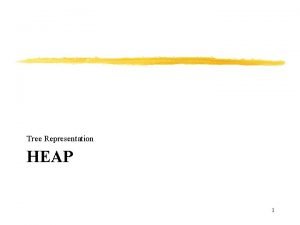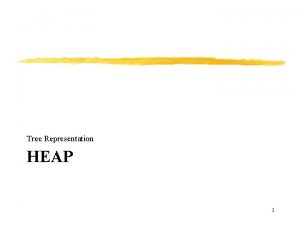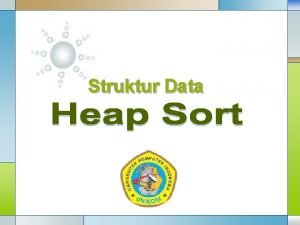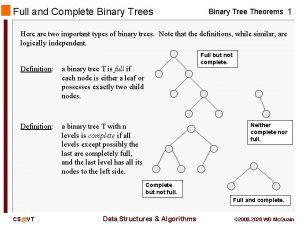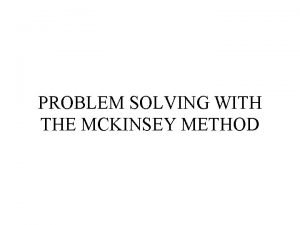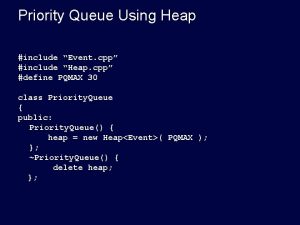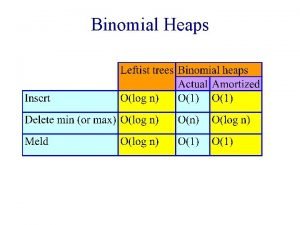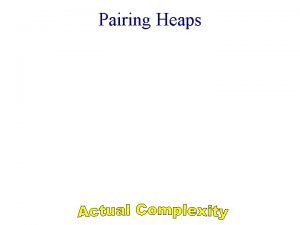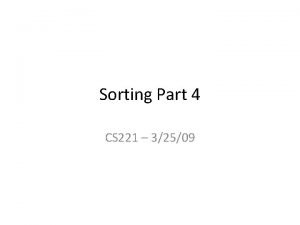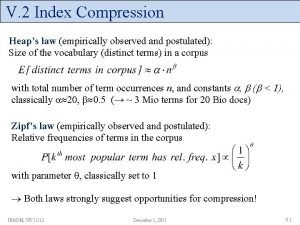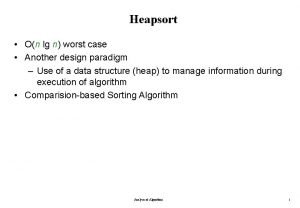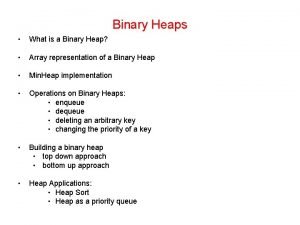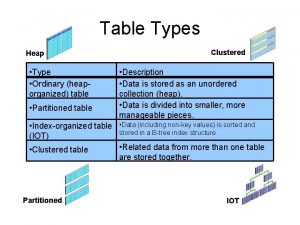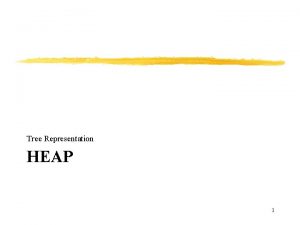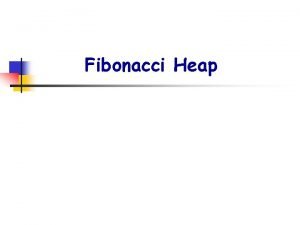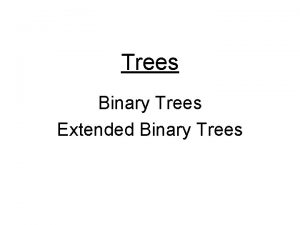Tree Representation HEAP 1 Sequential Representation of Trees


![Example root goes into first index Left = [2 i] right = [2 i+1]. Example root goes into first index Left = [2 i] right = [2 i+1].](https://slidetodoc.com/presentation_image_h/e2e23a4c240d43cad266aa1d4da465e1/image-3.jpg)






![Heap: An example [1] [2] [3] [4] 10 20 25 30 10 30 20 Heap: An example [1] [2] [3] [4] 10 20 25 30 10 30 20](https://slidetodoc.com/presentation_image_h/e2e23a4c240d43cad266aa1d4da465e1/image-10.jpg)
![Heap: An example [1] [2] [3] [4] 10 20 25 30 10 30 20 Heap: An example [1] [2] [3] [4] 10 20 25 30 10 30 20](https://slidetodoc.com/presentation_image_h/e2e23a4c240d43cad266aa1d4da465e1/image-11.jpg)
![Heap: An example [1] [2] [3] [4] 10 20 25 30 10 30 20 Heap: An example [1] [2] [3] [4] 10 20 25 30 10 30 20](https://slidetodoc.com/presentation_image_h/e2e23a4c240d43cad266aa1d4da465e1/image-12.jpg)


![ADT Heap Operations: 1. Method Sift. Up (int n) requires: Elements H[1], H[2], …, ADT Heap Operations: 1. Method Sift. Up (int n) requires: Elements H[1], H[2], …,](https://slidetodoc.com/presentation_image_h/e2e23a4c240d43cad266aa1d4da465e1/image-15.jpg)









































- Slides: 56

Tree Representation HEAP 1

Sequential Representation of Trees Store the nodes in fixed positions: (i) root goes into first index, (ii) in general left child of tree[i] is stored in tree[2 i] and right child in tree[2 i+1]. 2
![Example root goes into first index Left 2 i right 2 i1 Example root goes into first index Left = [2 i] right = [2 i+1].](https://slidetodoc.com/presentation_image_h/e2e23a4c240d43cad266aa1d4da465e1/image-3.jpg)
Example root goes into first index Left = [2 i] right = [2 i+1]. A B C D E - - G - 1 2 3 4 5 6 7 8 9 10 11 12 G 3

Complete Tree • "complete tree" -- a complete tree is one in which there are no gaps between leaves. For instance, a tree with a root node that has only one child must have its child as the left node. More precisely, a complete tree is one that has every level filled in before adding a node to the next level, and one that has the nodes in a given level filled in from left to right, with no breaks. 4

5

Heaps • A heap is a complete binary tree. • A heap is best implemented in sequential representation (using an array). • The array is what’s stored in memory; the heap is only a conceptual representation. • Two important uses of heaps are: – (i) efficient implementation of priority queues – (ii) sorting -- Heapsort. 6

Efficient implementation of priority queues • Removal of the largest item is accomplished in fast O(1) time. • Insertion requires slow O(N) time, because an average of half the items in the array must be moved to insert the new one in order. • A heap is a kind of tree. It offers both insertion and deletion in O(log. N) time. • It’s the method of choice for implementing priority queues where speed is important and there will be many insertions. 7

Heaps • Max-Heap has max element as root. • Min-Heap has min element as root. “used in this lecture” • The elements in a heap satisfy heap conditions: for Min-Heap: key[parent] < key[left-child] or key[right-child]. 2 • The last node of a heap is the rightmost node of maximum depth 5 6 9 7 last node 8

A Heap 10 30 40 52 Any node’s key value is less than its children’s. 20 50 25 55 42 9
![Heap An example 1 2 3 4 10 20 25 30 10 30 20 Heap: An example [1] [2] [3] [4] 10 20 25 30 10 30 20](https://slidetodoc.com/presentation_image_h/e2e23a4c240d43cad266aa1d4da465e1/image-10.jpg)
Heap: An example [1] [2] [3] [4] 10 20 25 30 10 30 20 40 10 40 20 50 [5] 40 42 50 [6] [7] All the three arrangements satisfy min heap conditions [8] [9] 40 42 50 52 55 50 25 55 52 42 42 30 25 52 55 10 20 30 52 55 25 10
![Heap An example 1 2 3 4 10 20 25 30 10 30 20 Heap: An example [1] [2] [3] [4] 10 20 25 30 10 30 20](https://slidetodoc.com/presentation_image_h/e2e23a4c240d43cad266aa1d4da465e1/image-11.jpg)
Heap: An example [1] [2] [3] [4] 10 20 25 30 10 30 20 40 10 40 20 50 [5] 50 25 55 [6] [7] All the three arrangements satisfy min heap conditions [8] [9] 40 42 50 52 55 50 25 55 52 42 42 30 25 52 55 10 30 40 52 42 20 11
![Heap An example 1 2 3 4 10 20 25 30 10 30 20 Heap: An example [1] [2] [3] [4] 10 20 25 30 10 30 20](https://slidetodoc.com/presentation_image_h/e2e23a4c240d43cad266aa1d4da465e1/image-12.jpg)
Heap: An example [1] [2] [3] [4] 10 20 25 30 10 30 20 40 10 40 20 50 [5] 42 30 25 [6] [7] All the three arrangements satisfy min heap conditions [8] [9] 40 42 50 52 55 50 25 55 52 42 42 30 25 52 55 10 40 50 52 55 20 12

Constructing Heaps • There are two methods of constructing heaps: – Using Sift. Down operation. – Using Sift. Up operation. • Sift. Down operation inserts a new element into the Heap from the top. • Sift. Up operation inserts a new element into the Heap from the bottom. ”used in this lecture” 13

ADT Heap Elements: The elements are called Heap. Elements. Structure: The elements of the heap satisfy the heap conditions. Domain: Bounded. Type name: Heap. 14
![ADT Heap Operations 1 Method Sift Up int n requires Elements H1 H2 ADT Heap Operations: 1. Method Sift. Up (int n) requires: Elements H[1], H[2], …,](https://slidetodoc.com/presentation_image_h/e2e23a4c240d43cad266aa1d4da465e1/image-15.jpg)
ADT Heap Operations: 1. Method Sift. Up (int n) requires: Elements H[1], H[2], …, H[n-1] satisfy heap conditions. results: Elements H[1], H[2], …, H[n] satisfy heap conditions. 2. Method Sift. Down (int m, n) requires: Elements H[m+1], H[m+2], …, H[n] satisfy the heap conditions. results: Elements H[m], H[m+1], …, H[n] satisfy the heap conditions. 3. Method Heap (int n) // Constructor results: Elements H[1], H[2], …. H[n] satisfy the heap conditions. 15

ADT Heap: Element public class Heap. Element<T> { T data; Priority p; public Heap. Element(T e, Priority pty) { data = e; p = pty; } // Setters/Getters. . . } 16

Insertion into a Heap • Method insert. Item of the priority queue ADT corresponds to the insertion of a key k to the heap • The insertion algorithm consists of three steps – Find the insertion node z (the new last node) – Store k at z – Restore the heap-order property (discussed next) © 2010 Goodrich, Tamassia Heaps 17

Upheap • After the insertion of a new key k, the heap-order property may be violated • Algorithm upheap restores the heap-order property by swapping k along an upward path from the insertion node • Upheap terminates when the key k reaches the root or a node whose parent has a key smaller than or equal to k • Since a heap has height O(log n), upheap runs in O(log n) time 2 5 9 © 2010 Goodrich, Tamassia z 6 7 insertion node Heaps 18

Upheap • After the insertion of a new key k, the heap-order property may be violated • Algorithm upheap restores the heap-order property by swapping k along an upward path from the insertion node • Upheap terminates when the key k reaches the root or a node whose parent has a key smaller than or equal to k • Since a heap has height O(log n), upheap runs in O(log n) time 2 5 9 © 2010 Goodrich, Tamassia 6 7 Heaps 1 19

Upheap • After the insertion of a new key k, the heap-order property may be violated • Algorithm upheap restores the heap-order property by swapping k along an upward path from the insertion node • Upheap terminates when the key k reaches the root or a node whose parent has a key smaller than or equal to k • Since a heap has height O(log n), upheap runs in O(log n) time 2 5 9 © 2010 Goodrich, Tamassia 1 7 Heaps 6 20

Upheap • After the insertion of a new key k, the heap-order property may be violated • Algorithm upheap restores the heap-order property by swapping k along an upward path from the insertion node • Upheap terminates when the key k reaches the root or a node whose parent has a key smaller than or equal to k • Since a heap has height O(log n), upheap runs in O(log n) time 1 5 9 © 2010 Goodrich, Tamassia 2 7 Heaps 6 21

Upheap • After the insertion of a new key k, the heap-order property may be violated • Algorithm upheap restores the heap-order property by swapping k along an upward path from the insertion node • Upheap terminates when the key k reaches the root or a node whose parent has a key smaller than or equal to k • Since a heap has height O(log n), upheap runs in O(log n) time 1 5 9 © 2010 Goodrich, Tamassia 2 7 z 6 22 Heaps insertion node

Upheap • After the insertion of a new key k, the heap-order property may be violated • Algorithm upheap restores the heap-order property by swapping k along an upward path from the insertion node • Upheap terminates when the key k reaches the root or a node whose parent has a key smaller than or equal to k • Since a heap has height O(log n), upheap runs in O(log n) time 1 5 9 © 2010 Goodrich, Tamassia 2 7 Heaps 6 10 23

Upheap • After the insertion of a new key k, the heap-order property may be violated • Algorithm upheap restores the heap-order property by swapping k along an upward path from the insertion node • Upheap terminates when the key k reaches the root or a node whose parent has a key smaller than or equal to k • Since a heap has height O(log n), upheap runs in O(log n) time 1 5 z © 2010 Goodrich, Tamassia 9 2 7 Heaps 6 10 24

Upheap • After the insertion of a new key k, the heap-order property may be violated • Algorithm upheap restores the heap-order property by swapping k along an upward path from the insertion node • Upheap terminates when the key k reaches the root or a node whose parent has a key smaller than or equal to k • Since a heap has height O(log n), upheap runs in O(log n) time 1 5 9 © 2010 Goodrich, Tamassia 4 2 7 Heaps 6 10 25

Upheap • After the insertion of a new key k, the heap-order property may be violated • Algorithm upheap restores the heap-order property by swapping k along an upward path from the insertion node • Upheap terminates when the key k reaches the root or a node whose parent has a key smaller than or equal to k • Since a heap has height O(log n), upheap runs in O(log n) time 1 5 4 © 2010 Goodrich, Tamassia 9 2 7 Heaps 6 10 26

Upheap • After the insertion of a new key k, the heap-order property may be violated • Algorithm upheap restores the heap-order property by swapping k along an upward path from the insertion node • Upheap terminates when the key k reaches the root or a node whose parent has a key smaller than or equal to k • Since a heap has height O(log n), upheap runs in O(log n) time 1 4 5 © 2010 Goodrich, Tamassia 9 2 7 Heaps 6 10 27

Removal from a Heap (§ 7. 3. 3) • Method remove. Min of the priority queue ADT corresponds to the removal of the root key from the heap • The removal algorithm consists of three steps 2 5 9 7 last node 7 – Replace the root key with the key of the last node w – Remove w – Restore the heap-order property (discussed next) © 2010 Goodrich, Tamassia w 6 5 w 6 9 new last node Heaps 28

Downheap • After replacing the root key with the key k of the last node, the heaporder property may be violated • Algorithm downheap restores the heap-order property by swapping key k along a downward path from the root • Downheap terminates when key k reaches a leaf or a node whose children have keys greater than or equal to k • Since a heap has height O(log n), downheap runs in O(log n) time 2 5 9 © 2010 Goodrich, Tamassia 6 w 7 last node Heaps 29

Downheap • After replacing the root key with the key k of the last node, the heaporder property may be violated • Algorithm downheap restores the heap-order property by swapping key k along a downward path from the root • Downheap terminates when key k reaches a leaf or a node whose children have keys greater than or equal to k • Since a heap has height O(log n), downheap runs in O(log n) time 7 5 9 © 2010 Goodrich, Tamassia 6 w 7 last node Heaps 30

Downheap • After replacing the root key with the key k of the last node, the heaporder property may be violated • Algorithm downheap restores the heap-order property by swapping key k along a downward path from the root • Downheap terminates when key k reaches a leaf or a node whose children have keys greater than or equal to k • Since a heap has height O(log n), downheap runs in O(log n) time 7 5 w 6 9 © 2010 Goodrich, Tamassia delete last node Heaps 31

Downheap • After replacing the root key with the key k of the last node, the heaporder property may be violated • Algorithm downheap restores the heap-order property by swapping key k along a downward path from the root • Downheap terminates when key k reaches a leaf or a node whose children have keys greater than or equal to k • Since a heap has height O(log n), downheap runs in O(log n) time 7 5 6 9 © 2010 Goodrich, Tamassia Heaps Down. Heap/Sift. Down 32

Downheap • After replacing the root key with the key k of the last node, the heaporder property may be violated • Algorithm downheap restores the heap-order property by swapping key k along a downward path from the root • Downheap terminates when key k reaches a leaf or a node whose children have keys greater than or equal to k • Since a heap has height O(log n), downheap runs in O(log n) time 5 7 6 9 © 2010 Goodrich, Tamassia Heaps 33

Downheap • After replacing the root key with the key k of the last node, the heaporder property may be violated • Algorithm downheap restores the heap-order property by swapping key k along a downward path from the root • Downheap terminates when key k reaches a leaf or a node whose children have keys greater than or equal to k • Since a heap has height O(log n), downheap runs in O(log n) time 5 7 w 6 9 © 2010 Goodrich, Tamassia last node 34 Heaps

Downheap • After replacing the root key with the key k of the last node, the heaporder property may be violated • Algorithm downheap restores the heap-order property by swapping key k along a downward path from the root • Downheap terminates when key k reaches a leaf or a node whose children have keys greater than or equal to k • Since a heap has height O(log n), downheap runs in O(log n) time 9 7 w 6 9 © 2010 Goodrich, Tamassia last node Heaps 35

Downheap • After replacing the root key with the key k of the last node, the heaporder property may be violated • Algorithm downheap restores the heap-order property by swapping key k along a downward path from the root • Downheap terminates when key k reaches a leaf or a node whose children have keys greater than or equal to k • Since a heap has height O(log n), downheap runs in O(log n) time 9 w © 2010 Goodrich, Tamassia 7 6 delete last node Heaps 36

Downheap • After replacing the root key with the key k of the last node, the heaporder property may be violated • Algorithm downheap restores the heap-order property by swapping key k along a downward path from the root • Downheap terminates when key k reaches a leaf or a node whose children have keys greater than or equal to k • Since a heap has height O(log n), downheap runs in O(log n) time 9 7 © 2010 Goodrich, Tamassia 6 Down. Heap/Sift. Down Heaps 37

Downheap • After replacing the root key with the key k of the last node, the heaporder property may be violated • Algorithm downheap restores the heap-order property by swapping key k along a downward path from the root • Downheap terminates when key k reaches a leaf or a node whose children have keys greater than or equal to k • Since a heap has height O(log n), downheap runs in O(log n) time 6 7 © 2010 Goodrich, Tamassia 9 Heaps 38

Downheap • After replacing the root key with the key k of the last node, the heaporder property may be violated • Algorithm downheap restores the heap-order property by swapping key k along a downward path from the root • Downheap terminates when key k reaches a leaf or a node whose children have keys greater than or equal to k • Since a heap has height O(log n), downheap runs in O(log n) time 6 w 7 © 2010 Goodrich, Tamassia 9 Heaps last node 39

Downheap • After replacing the root key with the key k of the last node, the heaporder property may be violated • Algorithm downheap restores the heap-order property by swapping key k along a downward path from the root • Downheap terminates when key k reaches a leaf or a node whose children have keys greater than or equal to k • Since a heap has height O(log n), downheap runs in O(log n) time 9 w 7 © 2010 Goodrich, Tamassia 9 Heaps last node 40

Downheap • After replacing the root key with the key k of the last node, the heaporder property may be violated • Algorithm downheap restores the heap-order property by swapping key k along a downward path from the root • Downheap terminates when key k reaches a leaf or a node whose children have keys greater than or equal to k • Since a heap has height O(log n), downheap runs in O(log n) time 9 w 7 © 2010 Goodrich, Tamassia Heaps delete last node 41

Downheap • After replacing the root key with the key k of the last node, the heaporder property may be violated • Algorithm downheap restores the heap-order property by swapping key k along a downward path from the root • Downheap terminates when key k reaches a leaf or a node whose children have keys greater than or equal to k • Since a heap has height O(log n), downheap runs in O(log n) time 9 7 © 2010 Goodrich, Tamassia Down. Heap/Sift. Down Heaps 42

Downheap • After replacing the root key with the key k of the last node, the heaporder property may be violated • Algorithm downheap restores the heap-order property by swapping key k along a downward path from the root • Downheap terminates when key k reaches a leaf or a node whose children have keys greater than or equal to k • Since a heap has height O(log n), downheap runs in O(log n) time 7 9 © 2010 Goodrich, Tamassia Heaps 43

Heap-Sort • Consider a priority queue with n items implemented by means of a heap – the space used is O(n) – methods insert and remove. Min take O(log n) time – methods size, is. Empty, and min take time O(1) time © 2010 Goodrich, Tamassia • Using a heap-based priority queue, we can sort a sequence of n elements in O(n log n) time • The resulting algorithm is called heap-sort • Heap-sort is much faster than quadratic sorting algorithms, such as insertion-sort and selection -sort Heaps 44

Vector-based Heap Implementation • We can represent a heap with n keys by means of a vector of length n + 1 • For the node at rank i – the left child is at rank 2 i – the right child is at rank 2 i + 1 • Links between nodes are not explicitly stored • The cell of at rank 0 is not used • Operation insert corresponds to inserting at rank n + 1 • Operation remove. Min corresponds to removing at rank 1 2 5 6 9 0 7 2 5 6 9 7 1 2 3 4 5 – Yields in-place heap-sort © 2010 Goodrich, Tamassia 45 Heaps

Bottom-up Heap Construction • We can construct a heap storing n given keys in using a bottom-up construction with log n phases • In phase i, pairs of heaps with 2 i -1 keys are merged into heaps with 2 i+1 -1 keys © 2010 Goodrich, Tamassia Heaps 2 i -1 2 i+1 -1 46

Example 16 15 4 25 16 12 6 5 15 © 2010 Goodrich, Tamassia 4 7 23 11 12 6 Heaps 20 27 7 23 20 47

Example (contd. ) 25 16 5 15 4 15 16 11 12 6 4 25 © 2010 Goodrich, Tamassia 5 27 9 23 6 12 11 Heaps 20 20 9 23 27 48

Example (contd. ) 7 8 15 16 4 25 5 6 12 11 20 9 4 5 25 © 2010 Goodrich, Tamassia 27 6 15 16 23 7 8 12 11 Heaps 20 9 23 27 49

Example (end) 10 4 6 15 16 5 25 7 8 12 11 20 9 23 27 4 5 6 15 16 7 25 © 2010 Goodrich, Tamassia 10 8 12 11 Heaps 20 9 23 27 50

Merging Two Heaps • We are given two heaps and a key k • We create a new heap with the root node storing k and with the two heaps as subtrees • We perform downheap to restore the heap-order property © 2010 Goodrich, Tamassia Heaps 3 8 2 5 4 6 51

Merging Two Heaps • We are given two heaps and a key k • We create a new heap with the root node storing k and with the two heaps as subtrees • We perform downheap to restore the heap-order property © 2010 Goodrich, Tamassia Heaps k 7 3 8 2 5 4 6 52

Merging Two Heaps • We are given two heaps and a key k • We create a new heap with the root node storing k and with the two heaps as subtrees • We perform downheap to restore the heap-order property © 2010 Goodrich, Tamassia Heaps k 7 3 8 2 5 4 6 Merge 53

Merging Two Heaps • We are given two heaps and a key k • We create a new heap with the root node storing k and with the two heaps as subtrees • We perform downheap to restore the heap-order property © 2010 Goodrich, Tamassia Heaps 7 3 8 2 5 4 6 Downheap/Sift. Down 54

Merging Two Heaps • We are given two heaps and a key k • We create a new heap with the root node storing k and with the two heaps as subtrees • We perform downheap to restore the heap-order property © 2010 Goodrich, Tamassia Heaps 2 3 8 7 5 4 6 Downheap/Sift. Down 55

Merging Two Heaps • We are given two heaps and a key k • We create a new heap with the root node storing k and with the two heaps as subtrees • We perform downheap to restore the heap-order property © 2010 Goodrich, Tamassia Heaps 2 3 8 4 5 7 6 Downheap/Sift. Down 56
 Downheap algorithm
Downheap algorithm Sequential representation of binary tree
Sequential representation of binary tree Heap vs binary heap
Heap vs binary heap Fibonacci heap visualization
Fibonacci heap visualization Heap tree adalah
Heap tree adalah Binary search tree vs heap
Binary search tree vs heap Winner tree and loser trees
Winner tree and loser trees Selection trees
Selection trees Loser tree
Loser tree Elemen tree yang memiliki induk yang sama disebut....
Elemen tree yang memiliki induk yang sama disebut.... Linked representation of binary tree
Linked representation of binary tree Left child right sibling
Left child right sibling Objective tree analysis
Objective tree analysis Foragry
Foragry Ticks and dog relationship
Ticks and dog relationship 2-3-4 trees
2-3-4 trees Problem tree and objective tree
Problem tree and objective tree Problem tree definition
Problem tree definition Full binary tree and complete binary tree
Full binary tree and complete binary tree 7 steps problem solving mckinsey
7 steps problem solving mckinsey Kite runner literary devices
Kite runner literary devices H-tree clock tree synthesis
H-tree clock tree synthesis General tree to binary tree
General tree to binary tree Btree simulation
Btree simulation Gene tree vs phylogenetic tree
Gene tree vs phylogenetic tree Jelaskan definisi derivasi dan pohon sintaks!
Jelaskan definisi derivasi dan pohon sintaks! What is a threaded binary tree traversal?
What is a threaded binary tree traversal? Heap overflow
Heap overflow Time sort
Time sort Priority queue using heap
Priority queue using heap Skew heap
Skew heap Binomial heap calculator
Binomial heap calculator Binomial heap in c
Binomial heap in c Pairing heap
Pairing heap Contoh program merge sort c++
Contoh program merge sort c++ Double ended heap
Double ended heap Heap sort tutorial
Heap sort tutorial Collective noun stones
Collective noun stones Fibonacci heap application
Fibonacci heap application Heap binario
Heap binario Ternary heap
Ternary heap Quicksort animation
Quicksort animation Right hand grip rule
Right hand grip rule Vmmap heap
Vmmap heap Heaps law example
Heaps law example Binary heap animation
Binary heap animation Heapsort best case
Heapsort best case Insert element in priority queue
Insert element in priority queue Min heap
Min heap Max heap
Max heap Appear as heaps or piles
Appear as heaps or piles Bottom up heap construction visualization
Bottom up heap construction visualization Heap shape
Heap shape Heap exploitation techniques
Heap exploitation techniques Soal distribusi binomial doc
Soal distribusi binomial doc Heap in computer
Heap in computer What are heap-organized tables
What are heap-organized tables
